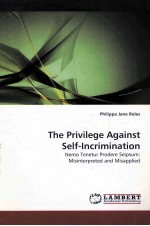图书介绍
THE PRIVILEGE AGAINST SELF-INCRIMINATION NEMO TENETUR PRODERE SEIPSUM:MISINTERPRETED AND MISAPPLIEDPDF|Epub|txt|kindle电子书版本网盘下载

- PHILIPPA JANE ROLES 著
- 出版社: LAP LAMBERT ACADEMIC PUBLISHING
- ISBN:3838304039
- 出版时间:2010
- 标注页数:244页
- 文件大小:9MB
- 文件页数:248页
- 主题词:
PDF下载
下载说明
THE PRIVILEGE AGAINST SELF-INCRIMINATION NEMO TENETUR PRODERE SEIPSUM:MISINTERPRETED AND MISAPPLIEDPDF格式电子书版下载
下载的文件为RAR压缩包。需要使用解压软件进行解压得到PDF格式图书。建议使用BT下载工具Free Download Manager进行下载,简称FDM(免费,没有广告,支持多平台)。本站资源全部打包为BT种子。所以需要使用专业的BT下载软件进行下载。如BitComet qBittorrent uTorrent等BT下载工具。迅雷目前由于本站不是热门资源。不推荐使用!后期资源热门了。安装了迅雷也可以迅雷进行下载!
(文件页数 要大于 标注页数,上中下等多册电子书除外)
注意:本站所有压缩包均有解压码: 点击下载压缩包解压工具
图书目录
List of Statutes5
List of Cases7
Acknowledgements14
Introduction15
Chapter One:The Privilege Against Self-Incrimination21
1.1 The Concept of Privilege Generally21
1.2 The Privilege Against Self-Incrimination26
1.2.1 UK Statutory Recognition of the Claim to Privilege in Civil Proceedings27
1.2.2 UK Statutory Recognition of the Claim to Privilege in Criminal Proceedings28
1.2.3 The Absence of a Statutory Recognition of the Claim to Privilege in Extra- Judicial Proceedings and Investigations29
1.2.4 Recognition of the Privilege in the United States of America: Protected by Constitutional Overlay29
1.3 A Personal Protection Only32
1.4 Limitations on the Privilege34
1.4.1 Only Applies to Evidence in Respect of Acts Deemed Criminal Under UK Law35
1.4.2 Restrictions on the Types of Evidence to which the Privilege Applies36
1.4.2.1 Testimonial Evidence38
1.4.2.2 Real Evidence39
1.4.2.3 Documentary Evidence41
1.5 Summary46
Chapter Two:Development of the Privilege47
2.1 How was the Privilege Created?47
2.1.1 Evolution of a Twelfth Century Maxim47
2.1.2 The Creation of Defence Counsel54
2.2 Historical Criticism of the Privilege: Jeremy Bentham56
2.3 Development of the Privilege in the Twentieth Century58
2.3.1 Development of the Privilege by the UK Courts prior to Saunders v UK60
2.3.2 Development of the Privilege by the European Court of Human Rights65
Chapter Three:The Privilege Against Self-Incrimination: Is ft a Right?70
3.1 Introduction70
3.2 Basic Linguistic Distinction Between 'Privilege' and 'Right'71
3.3 The Right to Silence74
3.4 The Presumption of Innocence77
3.5 Interaction with the Right to a Fair Trial79
3.6 Conclusion84
Chapter Four:Procedure for Invoking the Privilege & the Effect of a Successful Claim86
4.1 How is the Privilege Invoked?86
4.1.1 Invoking the Privilege Before the Court86
4.1.2 Relying on the Privilege During an Investigatory Interview or Extra -Judicial Proceedings87
4.2 A Real and Appreciable Risk of Prosecution88
4.3 What Proceedings Can the Privilege be Invoked In?94
4.4 How Far Does the Right to Claim Privilege Extend Beyond Criminal Cases?96
4.5 The Effect of a Successful Claim to Privilege and the Role of Adverse Inference100
4.6 The Judicial Discretion to Exclude Unfairly Obtained Evidence101
4.6.1 The Common Law Position on the Judicial Discretion to Exclude Evidence102
4.6.2 Section 78 of the Police and Criminal Evidence Act 1984 ("PACE")106
4.7 The Relevance of the Judicial Discretion to Exclude Unfairly Obtained Evidence to the Recognition of the Privilege Against Self-Incrimination111
Chapter Five:The Privilege Abrogation in Respect of Corporate Fraud113
5.1 Introduction113
5.2 Practical Examples of Fraud115
5.3 Defining Corporate Fraud118
5.4 The Courts Developed Remedies to Assist the Victims of Fraud120
5.5 The Power of the Authorities to Investigate Corporate Fraud125
5.5.1 The Serious Fraud Office and the Criminal Justice Act 1987126
5.5.2 The Department of Trade and Industry and the Companies Act 1985128
5.6 Should the SFO be Treated Differently to the DTI?133
5.7 Sharing Evidence133
5.8 Should Corporate Fraud be Treated Differently to Ordinary Fraud?136
5.9 Conclusion140
Chapter Six:Saunders v United Kingdom141
6.1 Introduction141
6.2 The Background142
6.3 The Preliminary Proceedings and the Prosecution142
6.4 The Appeal143
6.5 The Application Under the European Convention on Human Rights144
6.5.1 The Decision of the European Court of Human Rights145
6.5.2 Dissenting Opinion148
6.6 Grounds on Which the Judgment Could be Distinguished150
6.7 The Immediate Aftermath151
6.7.1 R v Lyons: Retrospective Application of the European Court of Human Rights Ruling151
6.7.2 The Attorney General's Note for Prosecutors153
Chapter Seven:Developments in UK Legislation Following Saunders v United Kingdom154
7.1 Introduction154
7.2 The Enactment of the Human Rights Act 1998154
7.3 The Rise of Use Immunity156
7.3.1 Existing Use Immunity Provisions157
7.3.2 Use Immunity and the Powers of the SFO and DTI160
7.3.3 Use Immunity and the Powers of Other Investigative Agencies161
7.4 Legislation Taking Effect After Youth Justice and Criminal Evidence Act 1999164
7.5 Does Use Immunity Fully Avoid Privilege Issues?168
7.5.1 The Fruit of the Poisoned Tree168
7.5.2 The Impact of Extradition172
7.6 Conclusion174
Chapter Eight:Developments in the Courts Following Saunders v United Kingdom175
8.1 Introduction175
8.2 Developments by the European Court of Human Rights175
8.3 Developments by the UK Courts177
8.4 Conclusion182
Chapter Nine:Addressing the Arguments for Retention of the Privilege183
9.1 Introduction183
9.2 Individual Concerns186
9.2.1 Individual Autonomy186
9.2.2 Personal Privacy189
9.3 Arguments Concerning the Operation of the Legal System191
9.3.1 The Presumption of Innocence191
9.3.2 To Prevent Abuse of Power by the State191
9.3.3 To Protect the Accusatorial System of Justice192
9.3.4 To Protect the Quality of Evidence193
9.4 Summary194
Chapter Ten:Utilising the Principles of Proportionality and Legitimate Aim to Qualify the Privilege196
10.1 Introduction196
10.2 Legitimate Aim199
10.3 Proportionality201
10.4 Applying the Principle of Proportionality and Legitimate Aim to Abrogate the Privilege: Section 172 Road Traffic Act204
10.5 Can the Restriction of the Privilege in Fraud Investigations be Justified?207
Chapter Eleven:The Privilege Abrogation for the Investigation of Tax Frauds210
11.1 Background210
11.2 Statutory Powers of Investigation211
11.3 Classification of Proceedings as Administrative213
11.4 The Disclosure Notice217
11.5 Conclusion219
Chapter Twelve:Competition Law221
12.1 Introduction221
12.2 Articles 81 & 82 of the EC Treaty222
12.3 European Community Council Regulation 1/2003223
12.4 The Competition Act 1998228
12.5 Enterprise Act 2002232
12.6 Conclusion234
Conclusion235
Bibliography239